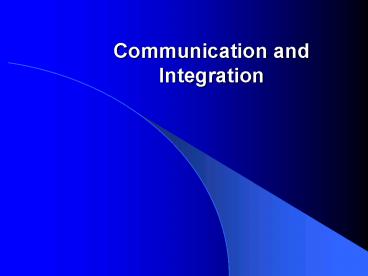Communication and Integration - PowerPoint PPT Presentation
1 / 47
Title:
Communication and Integration
Description:
Categories of Membrane Receptors and Effectors. Ligand-gated channels ... Binding to receptor opens/closes channel gate. Non-receptor ligand gated ion channels ... – PowerPoint PPT presentation
Number of Views:26
Avg rating:3.0/5.0
Title: Communication and Integration
1
Communication and Integration
2
Methods of Cell to Cell Communication
- Direct transfer
- Gap junctions
- Contact-dependent signals
- Cell adhesion molecules
- Local chemical communication
- Paracrine
- Autocrine
- Long distance communication
- Electrical
- Chemical (Endocrine)
3
(No Transcript)
4
(No Transcript)
5
(No Transcript)
6
(No Transcript)
7
(No Transcript)
8
Signal Pathways
- Common features
- Ligand binds to receptor
- Ligand binding activates receptor
- Intracellular molecules activated
- Last signal molecule
- Initiates synthesis of target protein
- Modifies target protein
- RESPONSE
9
Signal Pathways
- Receptors
- Bind ligand
- Signal transduction
- Receptor locations
- Nucleus
- Cytosol
- Cell membrane
- Lipophobic (hydrophilic) ligands
10
Categories of Membrane Receptors and Effectors
- Ligand-gated channels
- Integrins linked to cytoskeleton
- Receptor-enzymes
- G protein-coupled receptors
11
(No Transcript)
12
(No Transcript)
13
Ligand Gated Channels
- Simplest Receptors
- Binding to receptor opens/closes channel gate
- Non-receptor ligand gated ion channels
- Second messenger linked ion channels
- cAMP
- Membrane effectors
- G proteins
14
(No Transcript)
15
Integrin Receptors
- Integrins
- Membrane spanning proteins
- Bind to ECM or ligands (extracellular)
- Ligand binding
- Activates intracellular enzymes
- OR
- Alters cytoskeleton organization
16
Receptor Enzymes
- Receptors on extracellular side, enzymes on
intracellular side - Enzymes
- Protein kinases
- Tyrosine kinase
- Guanylyl cyclase (GTP?cGMP)
- Ligands
- Growth factors
- Cytokines
- Insulin
17
(No Transcript)
18
G Protein Coupled Systems
- Activation of ion channels
- G proteins linked to amplifier enzymes
- Adenylate cyclase
- ATP?cAMP
- cAMP?protein kinase A
- Guanylate cyclase
- GTP?cGMP
- cGMP?Phosphodiesterase
- Phospholipase C
- Phospholipase C?DAG IP3
19
(No Transcript)
20
(No Transcript)
21
(No Transcript)
22
Calcium
- Ionic messenger
- Extracellular calcium enters when channels open
- Intracellular calcium stored in ER
- Calcium dependent event
- Binding to calmodulin
- Binding to other regulatory proteins
- Movement of contractile proteins
- Exocytosis
- Binding to ion channels
- Embryo development
23
(No Transcript)
24
Nitric Oxide and Carbon Monoxide
- Soluble gases
- Paracrine action
- NO synthesized by nitric oxide synthase
- Activates guanylyl cyclase resulting in cGMP
formation - NO actions
- Brain neurotransmitter, neuromodulator
- Blood vessels - vasodilation
25
Lipid Messengers
- Products of arachidonic acid
- Leukotrienes
- Produced by lipoxygenase
- Airway smooth muscle constriction
- Anaphylaxis
- Prostanoids
- Produced by cycloxygenases (COX1, COX2)
- Prostaglandins, thromboxanes
- Inflammation, sleep, pain, fever
26
(No Transcript)
27
Signal Modulation
- Saturation, Specificity and Competition
- Agonist
- Mimic normal ligand
- Bind to and activate receptor
- Antagonist
- Oppose action of ligand
- Bind to and block receptor
28
(No Transcript)
29
Multiple Receptors
- Receptor isoforms
- Variants with similar binding properties BUT
differing cellular response - Cellular response depends on specific isoform NOT
on ligand
30
(No Transcript)
31
Up and Down Regulation
- Saturation
- Fixed number of receptors
- Down regulation
- Number of receptors decreases
- OR
- Binding affinity of receptor decreases
- Up regulation
- Number of receptors increases
32
Signal Termination
- First messenger degraded by enzymes in
extracellular fluid - Removal of first messenger by transporting into
cells - Ligand-receptor complex can be endocytosed and
degraded
33
Homeostasis
- Tonic Control
- Antagonistic Control
- Local Control
- Localized change and response
- Paracrine or autocrine
- Reflex Control
- Long distance reflex control pathways
- Nervous, endocrine or cytokine
- Response loop
- Input?Integration?Output
34
(No Transcript)
35
(No Transcript)
36
Response Loop
- Stimulus
- Sensory receptor
- Specialized cells or parts of cells
- Minimum threshold
- Afferent pathway?Integrating center?
- Efferent pathway
- Effectors
- Cells that carry out the response( must have
proper receptor) - Muscles, glands
- Response
37
(No Transcript)
38
(No Transcript)
39
Modulating the Response Loop
- Setpoints
- Negative feedback loops
- Opposes original signal
- Homeostatic
- Positive feedback loops
- Reinforces original signal
- Feedforward control
- Reflex that anticipates change
40
(No Transcript)
41
(No Transcript)
42
Biological Rhythms
- Circadian rhythm
- Diurnal
- Nocturnal
- Seasonal rhythm
43
Comparison of Nervous and Endocrine Systems
- Specificity
- Nervous Specific target cell
- Endocrine Less specific target but receptors
specific - Nature of signal
- Nervous Electrical and chemical
- Endocrine Hormonal (chemical)
- Speed
- Nervous faster than endocrine
44
Comparison of Nervous and Endocrine Systems
- Duration of Action
- Nervous shorter duration than endocrine
- Short term function nervous
- Long term function endocrine
- Coding for stimulus intensity
- Nervous frequency of impulses
- Endocrine hormone concentration
45
Pathways
- Endocrine reflexes
- Endocrine cells act as receptors and integrating
centers (no afferent path) - Efferent pathway is the hormone
- Nervous reflexes
- Receptor stimulated
- Afferent neuron to integrating center
- Efferent neuron to target
- Neuroendocrine
- Receptor stimulated
- Afferent neuron to integrating center
- Efferent neuron releases neurohormone into blood
46
(No Transcript)
47
(No Transcript)

